Polar Bear Population Trends: An In-Depth Analysis
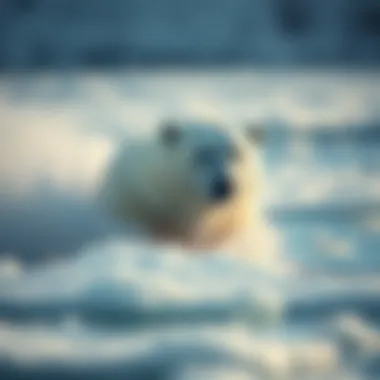
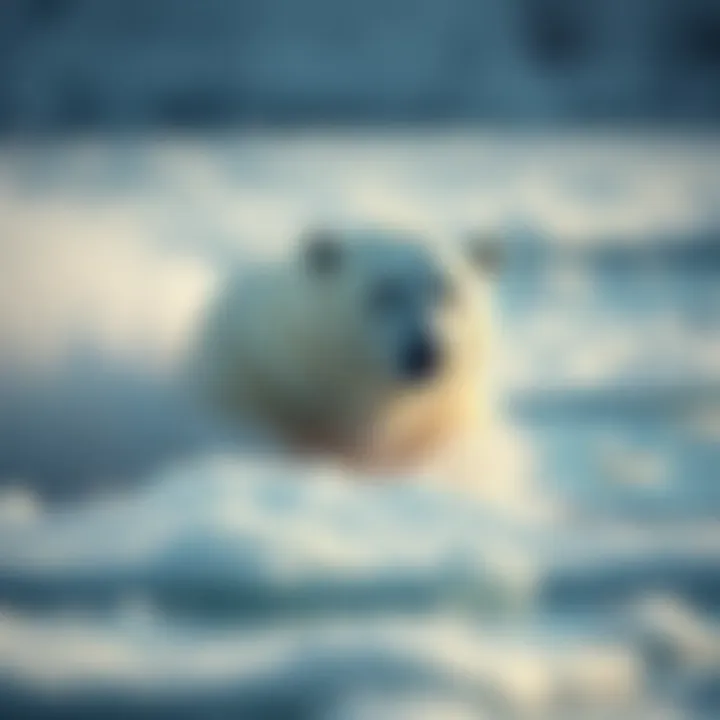
Intro
The polar bear, a remarkable creature of the Arctic, has captured the fascination of many. Known scientifically as Ursus maritimus, these majestic mammals are part of the unique ecosystem that the polar ice provides. However, observing their population trends over the past decades reveals a somber narrative, starkly shaped by climate change and human activities. To fathom the fluctuations in polar bear numbers, it’s essential to delve into their characteristics, habitat, and the pressing challenges they face. This overview provides a pathway into understanding the real stakes involved for this species and why their future is closely tied to ours.
Animal Species Profile
Prolusion to the animal species
Polar bears are not only iconic symbols of the Arctic but also pivotal players in their environments. They predominantly depend on sea ice for hunting seals, which forms a critical part of their diet. Their existence demonstrates the intricate balance of nature, showcasing how one species' fate can influence broader ecological dynamics.
Physical characteristics and appearance
A polar bear typically weighs between 900 to 1,600 pounds, with males being significantly larger than females. They possess a thick layer of insulating fat and a dense fur coat, which appear white but can take on a yellowish hue, especially in aging bears. Their large, powerful limbs and massive paws make them efficient swimmers, capable of covering miles in icy waters. Additionally, polar bears have keen eyesight and an acute sense of smell, which they use effectively to hunt for food.
Natural habitat and distribution
These bears call the Arctic home, residing across places like Alaska, Canada, Greenland, and parts of Russia. Their habitat is defined by the presence of sea ice, which they depend on for reaching their primary food sources. As sea ice melts due to rising global temperatures, the polar bear's territory is inversely shrinking, which restricts their mobility and access to food.
Behavior and social interactions
Polar bears are solitary animals, primarily coming together during mating season or when a mother is caring for her cubs. Their social interactions are often limited; however, they exhibit playful behaviors and sometimes will engage with each other in a meaningful way. While navigating their harsh terrain, communication through body language and vocalizations can be observed, providing a glimpse into their adaptive behaviors.
Conservation & Wildlife Efforts
Overview of conservation status
The conservation status of polar bears has been categorized as vulnerable, with their populations declining significantly due to climate change. The International Union for Conservation of Nature (IUCN) recognizes the species as one that requires immediate conservation efforts to avert further declines.
Threats to the species
- Climate Change: The principal threat, manifesting in loss of sea ice habitat.
- Oil and Gas Exploration: Activities in the Arctic pose risks through potential spills and disruption.
- Pollution: Chemical contaminants in the environment affect their health.
- Human-Polar Bear Conflicts: As habitats shrink, encounters become more frequent and dangerous for both parties.
Conservation initiatives and organizations
Numerous organizations and initiatives are dedicated to protecting polar bears. Notable players include:
- World Wildlife Fund (WWF): Actively works towards sustainable Arctic policies.
- Polar Bears International: Focuses on research and education to foster awareness.
- U.S. Fish and Wildlife Service: Engages in direct conservation efforts as part of domestic legislation.
Success stories and impact
While the situation remains dire, success stories such as habitat protection and breeding programs do show promise. For example, conservation measures undertaken in areas like the Chukchi Sea have helped support localized population recovery, indicating that concerted efforts can yield positive results.
Animal Behavior & Psychology
Communication and language cues
Communication among polar bears often relies on physical cues, like the use of specific postures, growls, or grumbles to convey messages, particularly in social interactions between mothers and their cubs.
Reproductive behavior and parenting
Polar bear mothers exhibit intricate nurturing behaviors. After a gestation period of about eight months, typically, one or two cubs are born, who stay with their mother for up to two and a half years, learning essential survival skills.
Cognitive abilities and problem-solving skills
Polar bears display remarkable problem-solving skills, particularly in accessing food sources. For instance, they have been observed using tools like ice to leverage seals out of holes, showcasing their intelligence.
Emotional intelligence and social dynamics
Much research is yet needed in the emotional intelligence realm of polar bears; however, their bond between mothers and cubs reflects a deeper social fabric that aids in the survival of the young.
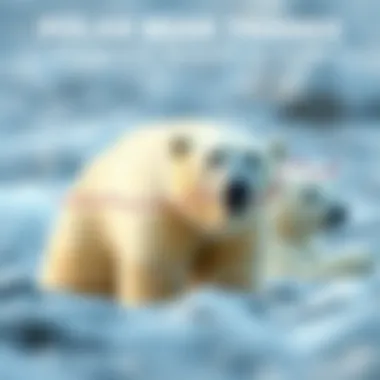
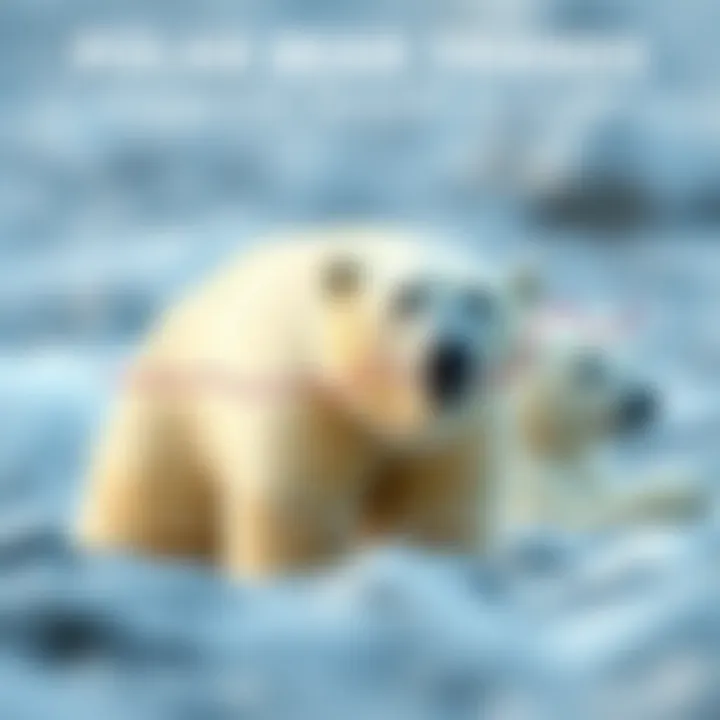
Unique Facts & Trivia
- Polar bears can overheat — despite living in freezing temperatures — during a good hunt due to their heavy fur coat.
- They are the world’s largest land carnivores, with some individuals reaching nearly ten feet in length!
- Polar bears are not truly white; their fur is transparent and hollow, helping to trap sunlight and provide insulation.
Preamble to Polar Bear Population Dynamics
Understanding polar bear population dynamics is crucial to grasping the broader narrative of wildlife conservation in an age marked by rapid environmental change. These majestic animals, the largest land carnivores, serve as a vital indicator species for the health of the Arctic ecosystem. When we talk about population dynamics, it isn't just numbers and statistics—it embodies the intricate dance between the bears and their habitat, the pressures they face, and the significance of maintaining a balance in nature.
Historical trends tell us a lot. For instance, going back several decades, we see shifts in population due to various factors, from hunting practices to climate variations. Such insights allow for effective management strategies. Knowing where polar bear populations stand today helps predict future challenges and assures that measures can be adapted proactively.
Moreover, monitoring these populations isn't merely for the sake of numbers—it's about understanding the health of entire ecosystems. A decline in polar bear numbers can signal dire consequences for many other species, thus echoing the need for a holistic approach to wildlife management. This aspect underscores our responsibility as stewards of the environment, grappling with the implications of our choices on wildlife and the delicate balance of nature.
When considering the impacts of this information, it becomes clear that every bit of data gathered about the polar bears can help inform conservation efforts. Such undertakings are vital today, as climate change holds the reins over many ecosystems, including the polar bear’s icy realm. In summary, exploring polar bear population dynamics sets the stage for a broader discussion on wildlife conservation, identifying trends not just for the sake of fascination but as a pathway to informed action.
Historical Overview of Polar Bear Populations
The historical overview of polar bear populations illustrates a narrative of resilience, but also of vulnerability. Prior to the 20th century, polar bears thrived in their Arctic habitats, with numbers that fluctuated somewhat naturally, as with most species. However, the early 1900s brought about intense hunting pressures due to commercial pursuits, drastically reducing their populations in some areas.
A notable rebound occurred through rigorous conservation efforts and legal protections in the latter half of the century. In regions like Alaska and Canada, measures were enacted to stabilize or even increase populations. Reports suggest that by the late 1980s, certain populations had shown signs of recovery. Yet, the landscape remains precarious; shifts in sea ice patterns are now emerging as a new frontier of challenges for these bears.
The establishment of various protected areas has been instrumental in sheltering polar bear habitats, but it is not an outright solution. As their historical numbers show, fluctuations can be frequent and drastic, largely influenced by both human actions and climatic shifts.
Importance of Monitoring Populations
Monitoring polar bear populations is as critical as keeping an eye on the stock market—it informs a host of decisions and highlights emerging trends. With current estimates suggesting that their numbers hover around 26,000 across the Arctic regions, keeping track of these populations helps scientists assess environmental changes.
The intricate methods of data collection, be it through aerial surveys or tagging techniques, allow for a deeper understanding of bear movements and behaviors. Often, this data leads to the development of management plans that can mitigate potential conflicts with humans or help establish corridors that connect fragmented habitats.
"Monitoring isn't just a routine; it's pivotal for spotting dips or rises in population that might signal larger environmental issues at play."
In addition, it has implications for policy-making and funding for conservation initiatives. When communities understand the populations are at risk, it can galvanize local and global efforts to address climate change more vigorously. Ultimately, this practice isn't just about counting bears; it’s about ensuring a future where polar bears continue to reign over the frozen expanses they call home, serving as symbols of the untouched wilderness and ongoing battles for biodiversity.
Annual Population Estimates
Annual population estimates are crucial for understanding the dynamics of polar bear populations. These estimates provide insights into how their numbers fluctuate year by year, influencing conservation strategies and policy-making. By examining the annual data, researchers gain a clearer picture of population health, enabling more effective interventions. Determining accurate population estimates also aids in recognizing the impacts of environmental changes and human interactions.
Population Trends in the Arctic Region
The Arctic region is the heartland of polar bear habitat. Over the decades, satellite imagery and aerial surveys have painted a vivid picture of where these magnificent creatures roam. In the early 2000s, a significant decline in numbers was recorded due to melting sea ice, which is their primary hunting ground. Reports from the World Wildlife Fund indicated that populations in areas like the Chukchi Sea and Beaufort Sea were particularly affected. Recent studies indicate a possible stabilization of numbers in some regions; however, the long-term trend still raises concerns.
- Ice Coverage: Changes in sea ice coverage directly impact polar bear hunting grounds. Without sufficient ice, bears may struggle to find seals, leading to lower birth rates.
- Hunting Regulations: Some indigenous communities have adapted their hunting practices, showing how human outreach can positively impact population numbers.
- Predation and Competition: Changes in food web dynamics, including competition with other species, also factor into population data.
Regional Variations in Population Numbers
Not all polar bear populations are created equal; variation across different regions has substantial implications. In Greenland, for instance, population estimates remain stable due to effective local management practices, whereas Svalbard has seen more fluctuations due to higher human activity. The Barents Sea population has shown resilience, which may be linked to localized conservation measures that help mitigate human impact. Key factors attributing to these differences are:
- Geographical Barriers: Some populations are isolated, limiting gene flow and adaptability.
- Climate Resilience: Regions with stable ice coverage may allow for healthier populations.
- Regulatory Frameworks: Effective laws such as those governing hunting can play a significant role; areas with strict regulations often report better population health.
Longitudinal Studies and Data Collection Methods
Longitudinal studies are the backbone of understanding polar bear population trends over time. Tracking the same group of bears or specific regions allows scientists to distinguish between natural variability and concerning declines. Methods used in data collection include:
- Satellite Collaring: Some bears are fitted with GPS collars to monitor their movements and habitats, giving invaluable real-time data.
- Aerial Surveys: Regular aerial surveys help assess population distributions and densities across vast areas.
- Mark-Recapture Techniques: This reliable method estimates populations by capturing, marking, and releasing a subset of bears, then observing how many of these marked bears are recaptured later.
Through these various methods, a wealth of information becomes available that helps piece together the bigger picture regarding polar bear demographics and health. Collectively, these insights inform conservation efforts and support necessary interventions aimed at preserving these iconic Arctic inhabitants.
“Understanding population numbers is not just about counting bears; it’s about ensuring the future of a species in peril.”
For more resources on polar bear populations, one can refer to the findings at National Oceanic and Atmospheric Administration (NOAA) or International Polar Bear Conservation Guidelines for more detailed insights.
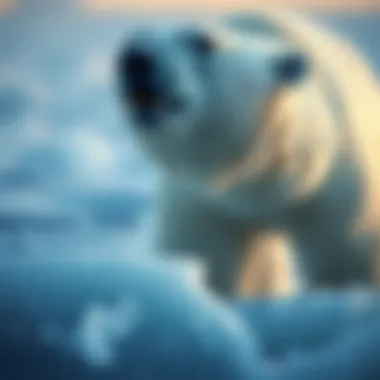
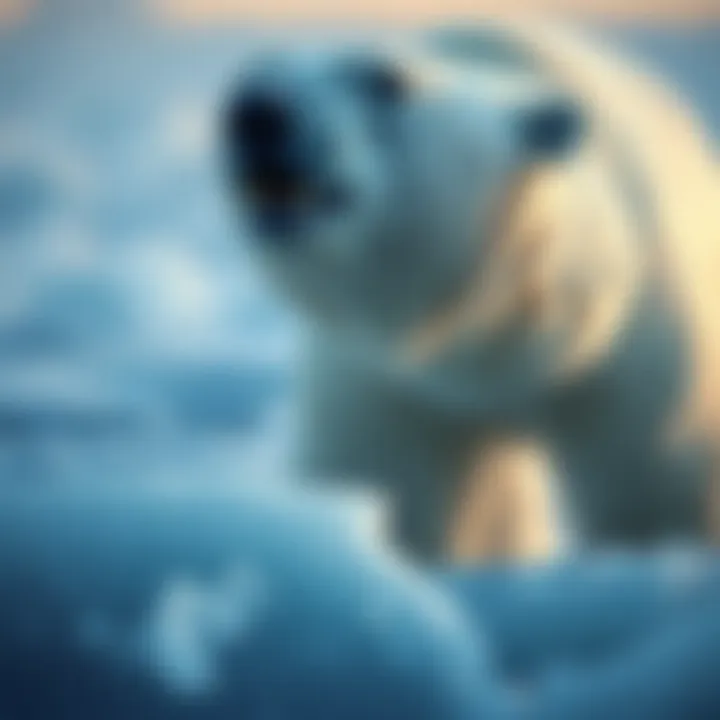
Influencing Factors on Population Numbers
Understanding the influencing factors on polar bear population numbers is crucial for grasping the wider implications of their conservation. These factors do not operate in isolation; rather, they are intertwined elements that drastically affect the well-being of polar bears. By deciphering these influences, we can better focus our conservation efforts and formulate effective strategies for maintaining viable populations.
Climate Change and Its Impact
One of the most pressing threats to polar bears comes from climate change. As the Earth warms, sea ice—their primary habitat—is rapidly diminishing. This ice serves as a hunting ground for polar bears, allowing them to catch seals, their main source of sustenance. With less ice, bears are forced to travel further and expend more energy in search of food, leading to malnutrition and decreased reproductive success. In practical terms, as the Arctic warms up, the intricacies of the ice dynamics shift, which can mean that bears have to alter their traditional hunting behaviors.
According to a study published by the U.S. Geological Survey, areas in the Arctic are experiencing temperature increases almost twice the global average. This shift not only alters the immediate environment but poses long-term challenges for breeding and raising cubs. Polar bears are facing a scenario where they struggle to find enough food, raising concerns about population stabilization.
Habitat Loss and Degradation
In conjunction with climate change, habitat loss and degradation represent significant dangers. The encroachment of industrial activities such as oil drilling and shipping lanes disrupts the migratory patterns and habitats necessary for polar bears. The Arctic region, once a remote zone, is becoming busier due to these activities, leading to habitat fragmentation.
Habitat degradation occurs not just from human activity but also as a direct consequence of climate shifts. Melting ice leads to habitat loss, ultimately pushing polar bears towards more populated areas. This shift creates a strain on resources, causing overlap with human settlements. If bears consistently wander into these regions, it leads to conflicts that often end in negative consequences for both parties.
Human-Wildlife Interaction
The escalation of human-wildlife interaction can have dire repercussions for polar bears. The increasing activities around polar regions mean there is a greater chance for encounters between bears and humans. Such interactions can lead to dangerous situations for both sides. For instance, bears that become too accustomed to human presence may start scavenging in towns, leading to negative perceptions and potential culling by authorities.
Moreover, when bears are forced into closer proximity with humans due to habitat loss, it not only stresses the bears but also increases the likelihood of injury or death due to vehicles, hunting, or territorial defense by humans. This trend underlines the need for improved wildlife management strategies that ensure both conservation of bears and safety for human populations.
Despite these challenges, optimism exists when cooperative conservation measures come into play, focusing on securing habitats and minimizing human-bear encounters. It’s essential to blend scientific research with public awareness to support the sustainability of not just the polar bears, but the ecosystem they inhabit.
"The fate of polar bears is indeed tied to the fate of the ice they depend upon, elevating climate action to the forefront of conservation efforts."
As we unravel the complexities behind population dynamics, it becomes evident that without addressing these core influencing factors, conservation undertakings may yield limited success. Understanding these elements is vital for informed decision-making in polar bear management and preservation.
Conservation Efforts and Challenges
Conservation of polar bears is not just a matter of protecting a beloved species; it’s about maintaining the delicate balance of their Arctic habitat. The health of the polar bear population reflects wider environmental concerns, making conservation efforts crucial. Not only do these efforts aim to reduce risks to the bears, but they also address the broader implications for the Arctic ecosystem and the communities that depend on it.
International Agreements and Policies
International cooperation is key in the fight for polar bears' survival. Several agreements play a critical role, such as the 1988 Agreement on the Conservation of Polar Bears, which was among the first binding commitments to protect this iconic species. Participating nations, namely the United States, Canada, Russia, Denmark, and Norway, agreed to enact measures to conserve polar bears and their habitats.
These agreements establish frameworks for research, monitor population statuses, and coordinate responses to challenges like climate change. Notably, they underline the importance of traditional ecological knowledge from indigenous peoples, ensuring that management practices respect local insights. Elements like these foster a sense of global responsibility for protecting polar bear habitats, creating a united front against the threats that endanger their survival.
On-the-Ground Conservation Practices
While international policies lay the groundwork, on-the-ground actions are what truly make a difference. Conservationists use a variety of strategies to protect polar bears and their ecosystems. Initiatives include:
- Habitat Preservation: Protecting critical breeding and feeding grounds from industrial activity and climate impact is paramount.
- Research and Monitoring: Regular population surveys help track bear numbers and health. Research focuses on understanding their behaviors in response to environmental changes, offering insights into how to best support them.
- Community-Based Approaches: Engaging local communities in conservation initiatives fosters stewardship and increases awareness. These programs can empower indigenous groups, allowing them to take active roles in the preservation of their traditional lands while integrating their wisdom into modern conservation practices.
Challenges in Effective Conservation
Despite significant efforts, numerous challenges threaten polar bear conservation. Admittedly, the road is fraught with obstacles:
- Climate Change: The most pressing issue today is climate change’s rapid impact on sea ice. As ice melts, polar bears find it increasingly difficult to hunt seals, their primary food source, leading to nutritional stress and declining populations.
- Habitat Degradation: Industrial activities, like oil drilling and shipping, pose direct threats to their habitat. Even limited access to their environment can disrupt their migratory patterns and hunting behaviors.
- Human-Wildlife Conflict: As polar bears venture closer to human settlements searching for food, conflicts become inevitable, resulting in risks for both bears and humans. Learning to manage these encounters safely is an ongoing challenge for conservationists.
The survival of the polar bear serves as a barometer for the health of the entire Arctic ecosystem, emphasizing the interconnected nature of environmental challenges we face today.
Ultimately, the efforts in conserving polar bears illustrate a microcosm of wider global environmental battles. Every accomplished action, whether policy-driven or grassroots, contributes to a broader understanding of sustainability, resilience, and shared responsibility in safeguarding our planet's biodiversity.
For more insights and ongoing updates on polar bear conservation, visit NOAA Fisheries and explore various conservation resources like those available on World Wildlife Fund.
Future Projections and Implications
Understanding the future of polar bear populations is not just an academic exercise; it's crucial for the long-term survival of these magnificent creatures. As climate change continues to reshape the Arctic, the implications for polar bears are far-reaching. Forecasting population trends provides insight into how conservation efforts must evolve. By analyzing projected changes, we can better prepare and implement strategies aimed at their survival.
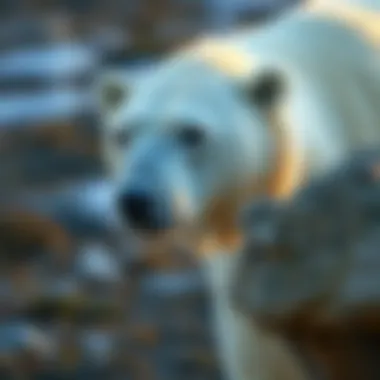
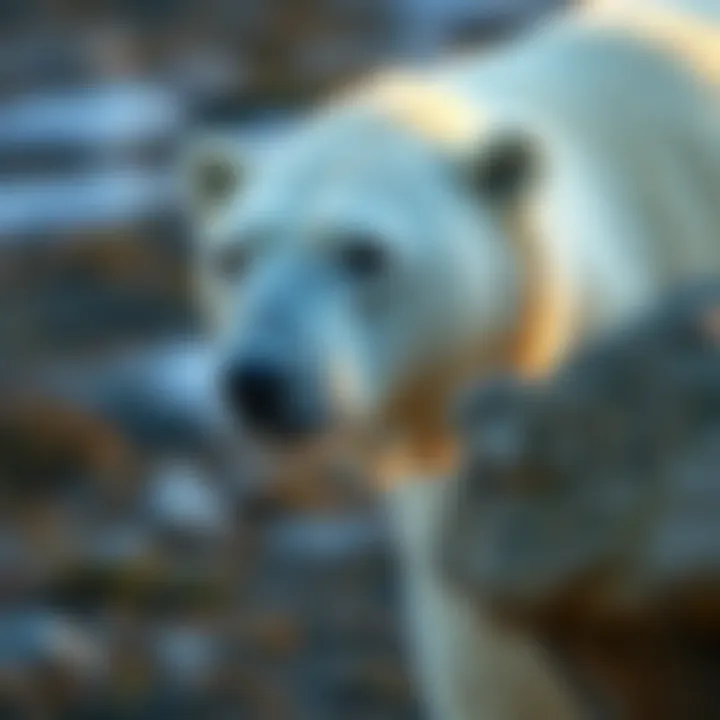
Expected Population Trends in the Coming Years
The future of polar bear populations is largely intertwined with the pace of climate change and its subsequent effects on their habitat. Prognostications suggest that by mid-century, many polar bear populations could see a significant reduction, primarily due to diminishing sea ice crucial for their hunting habits.
Some key trends expected include:
- Population Declines: Forecasts indicate that if current emissions trends continue, polar bear populations in regions such as the Beaufort Sea could plummet by 50% within the next few decades.
- Regional Disparities: While some populations may shrink drastically, others, particularly those in more resilient habitats, might fare slightly better. The Chukchi Sea bears, for example, are currently stable due to relatively healthier ice conditions.
- Adaptation to Changing Environments: There are indications that bears may adapt their hunting and migration patterns in response to changing ice conditions, yet this will depend highly on the availability of alternative food sources.
Scientific Modeling and Predictions
Scientific models play a pivotal role in predicting the future of polar bear populations. These models use complex algorithms and historical data to simulate different scenarios based on varying factors, such as ice melt rates and climate policies.
Key elements of scientific modeling in this context include:
- Data-Driven Insights: Models incorporate vast datasets, including satellite imagery of ice coverage and hunting data, to make informed predictions about future population trends.
- Scenario Planning: Different scenarios help stakeholders visualize outcomes based on current environmental policies versus aggressive conservation strategies. For example, models that factor in stringent emission reductions show a more hopeful outlook for polar bears.
- Continuous Monitoring: To validate these models, continuous monitoring of polar bear populations and their habitat conditions is essential. This ongoing data collection feeds back into the models, ensuring their accuracy remains intact over time.
The future of polar bears depends not just on our observations today but on our actions moving forward. Understanding projections helps us prioritize what needs to be done now.
The Role of Public Awareness in Conservation
In the realm of wildlife conservation, especially when it comes to polar bears, raising public awareness plays an essential role. The importance of this topic in the context of polar bear population trends cannot be overstated. As these magnificent creatures face a myriad of threats, understanding the driving forces behind their dwindling numbers is pivotal for effective conservation.
Public awareness fosters empathy for polar bears and encourages individuals to take action that supports their conservation. This initiative has far-reaching implications. It leads to increased funding for research, heightens support for social policies aimed at protecting wildlife, and facilitates greater community engagement. Each of these elements contributes to a broader effort to halt or even reverse the population decline of polar bears.
Educational Initiatives and Their Impact
Educational initiatives form the cornerstone of awareness campaigns targeting polar bear conservation. Programs tailored for schools and community groups have a lasting impact. These sessions educate participants about the ecological significance of polar bears and the threats they face, turning abstract concepts into relatable narratives.
To illustrate, many schools have adopted interactive programs that allow students to engage in local conservation efforts, be it through classroom activities or field trips to local wildlife reserves. As young minds understand the delicate balance of ecosystems, they often develop a sense of responsibility towards the natural world.
Moreover, online platforms have become indispensable in spreading knowledge. Social media pages and websites like en.wikipedia.org and britannica.com offer resources that can be accessed by anyone with an internet connection. This accessibility helps disseminate information rapidly and fosters grassroots movements aimed at driving change.
Community Involvement and Stakeholder Engagement
Community involvement is another critical aspect of public awareness in polar bear conservation. Engaging local communities ensures that conservation strategies are culturally relevant and more likely to be embraced. For instance, initiatives that involve Indigenous populations often yield richer insights into sustainable practices. When local stakeholders have a vested interest in preserving the ice habitats and hunting grounds of polar bears, they often become powerful allies in conservation efforts.
Additionally, organizations devoted to wildlife protection frequently hold community-based events where residents can participate in discussions, clean-up activities, and fundraising. These gatherings not only bolster community spirit but also deepen individuals' connections to the wildlife around them. The simple act of engaging with the environment—whether through volunteering for local NGOs or attending informational workshops—can morph passive observers into active practitioners of conservation.
"An informed public is essential for protecting wildlife. The more we know, the better we can act."
For further details on polar bear conservation, you might want to check usgs.gov or worldwildlife.org for more resources.
End
The conclusion of this article serves as a vital checkpoint in our exploration of polar bear population trends. It underscores not just the changing dynamics of these majestic creatures over the years but also emphasizes the significant challenges that they face in today’s world. Understanding these trends is paramount for multiple reasons, which this article has laid out in detail.
Summary of Key Findings
Throughout our discussions, several critical observations came to light:
- Population Declines: Evidence indicates that polar bear populations have seen notable declines in certain regions, particularly where ice habitat is rapidly diminishing due to climate change.
- Influencing Factors: The interplay of climate change, habitat loss, and increased human activity has complicated the survival of polar bears. Their reliance on sea ice for hunting seals makes them particularly vulnerable as temperatures rise.
- Conservation Efforts: Various international agreements, like the Polar Bear Conservation Strategy, aim to protect these animals. However, conservationists face numerous challenges, including funding and policy enforcement issues.
These findings draw a stark picture of a species that is not merely a symbol of the Arctic but a litmus test for environmental health. The fate of polar bears serves as a reflection of the broader implications of climate change and suggests that the strategies employed now are critical for future generations.
Final Thoughts on Conservation Strategies
The take-away messages from our analysis invite reflection and action. Conservation strategies need to adapt as swiftly as the environment changes. Here are some focal points that should shape our approach moving forward:
- Community Engagement: Local communities, often the frontline of conservation efforts, can play an influential role in habitat preservation and wildlife management, reinforcing the need for their involvement in policymaking.
- Sustainable Practices: Sustainable fishing and tourism practices must be promoted to mitigate human impact in polar bear habitats.
- Research and Monitoring: Continuous research is essential to adapt conservation strategies promptly, ensuring that they can respond to real-time changes in polar bear populations and their ecosystems.
By reflecting on these points, we can better appreciate the trajectory of polar bears and the need for a cohesive, informed approach to their conservation. Making strides today can shape a more promising outlook for tomorrow. In the end, the fate of the polar bear could well serve as a barometer for global environmental trends, reminding us how interconnected our actions are with nature’s delicate balance.
"What we do now echoes in eternity."
This sentiment rings particularly true for conservation efforts aimed at protecting polar bears and their habitat, as every action has repercussions for the future of our planet.
For more information on polar bear conservation, you can check out resources like World Wildlife Fund and U.S. Fish & Wildlife Service.
Understanding the importance of polar bears goes beyond admiration; it is about acknowledging their role in our ecosystem and embracing a responsibility towards ensuring their survival.







